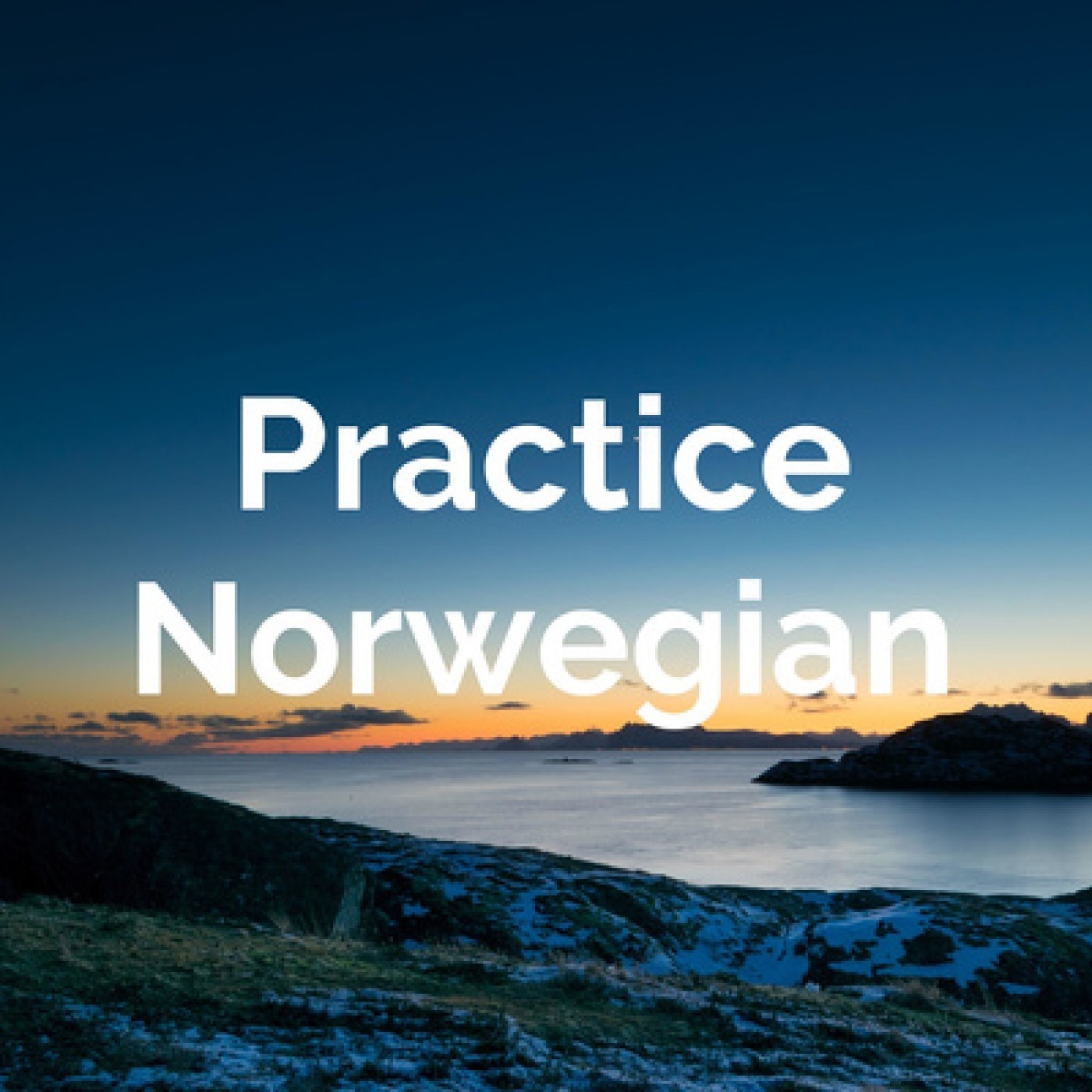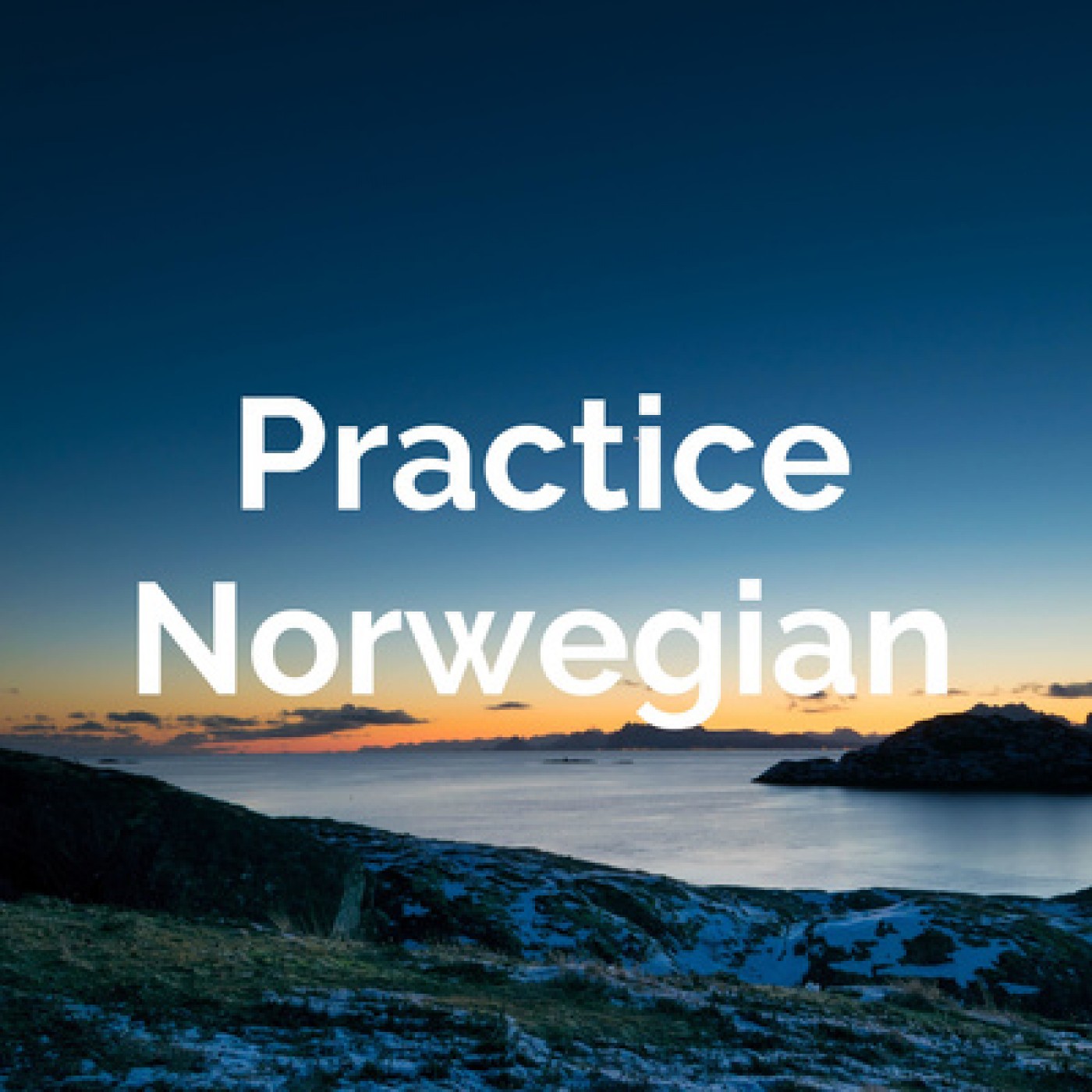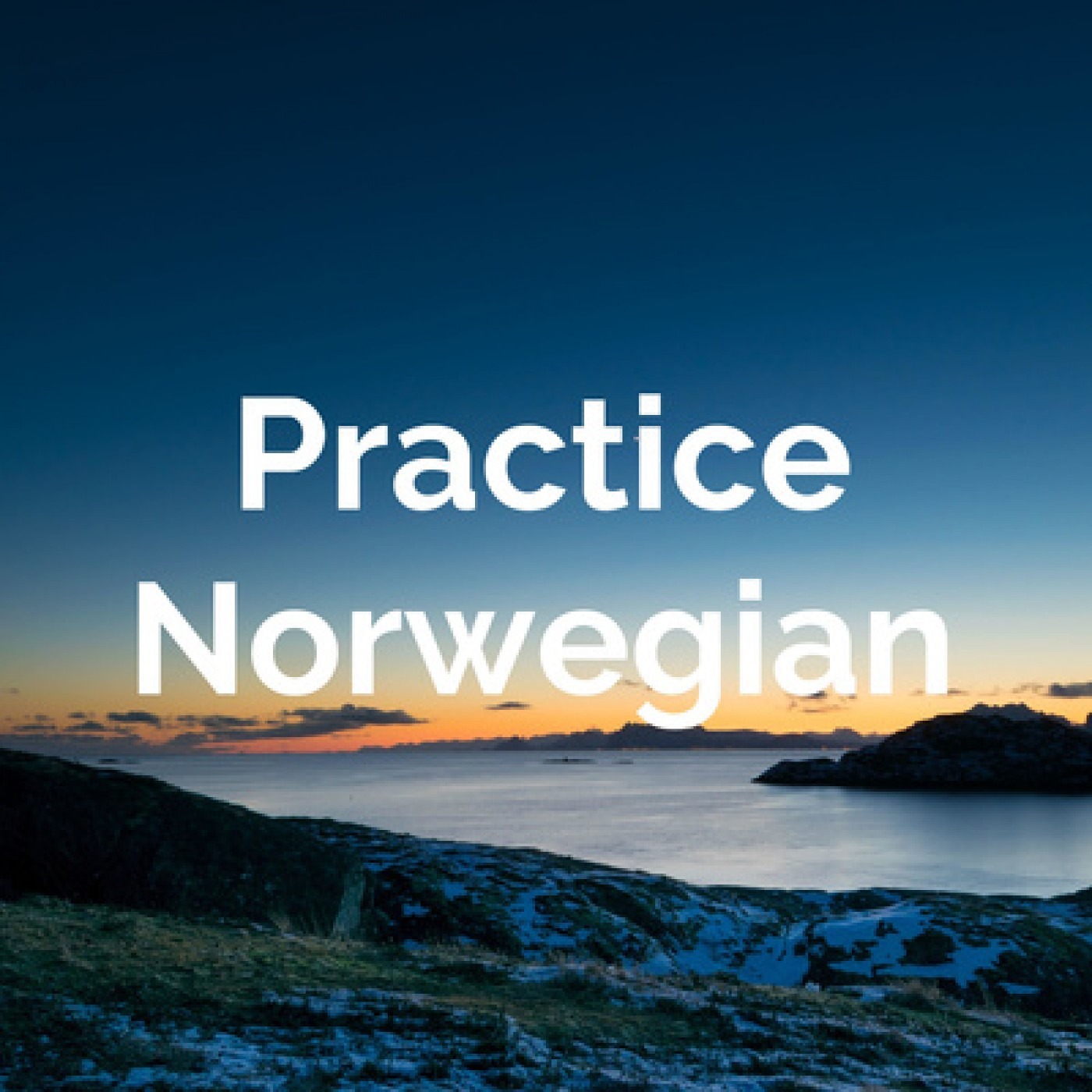Discover Practice Norwegian
Practice Norwegian

43 Episodes
Reverse
Good morning, and welcome! 🌇☕️ :)
This is the first episode of the Beginner Series on the Practice Norwegian Member Podcast, building on the Basic Grammar series!
For full transcripts of all the 50 Beginner Episodes, incl. summery of the Basic Grammar, visit here! https://www.amazon.com/dp/B09F16LK2 (https://www.amazon.com/dp/B09F16LK2W)
And get new "Morning Coffee" episodes twice a week - plus pronunciation tips, etymology for over 80 Norwegian words, and over 200 beginner, intermediate and advanced episodes here!
http://patreon.com/practicenorwegian (https://www.patreon.com/practicenorwegian) - Welcome!! 😊
Ha en super dag!
☀️😊🏞
Advertising Inquiries: https://redcircle.com/brands
Privacy & Opt-Out: https://redcircle.com/privacy
Updates!
Get new Morning Coffee episodes every morning on weekdays - plus 50 beginner episodes, pronunciation, etymology, and over 150 intermediate/advanced episodes! Visit: http://patreon.com/practicenorwegian - Welcome!! 😊
..
For more reading of Hamsun (and the 4th episode), please visit our Practice Norwegian Member Podcast here! 😊😊🎙🌟https://www.patreon.com/practicenorwegian
The novel "Sult" can be found here - it's older Norwegian from the original edition, and it's the text we're using in these episodes! https://www.amazon.com/dp/B09F1CGQJJ (Note: US/CA/AU store only)
Thanks so much for listening, and enjoy! :))
😄🌿☀️🏞🏞
:)
Advertising Inquiries: https://redcircle.com/brands
Privacy & Opt-Out: https://redcircle.com/privacy
In this episode we're starting a new little series about small bits of helpful and useful expressions, that are common in everyday speech.
And a very helpful way of not repeating the whole phrase in a reponse to a question, we often say f.ex. "Yes, I can" or "Yes, I do".
Ex:
Kan du sykle? Ja, det kan jeg.
Vil du spise? Ja, det vil jeg.
Sykler du til jobben? Ja det gjør jeg.
The rule is this:
kan, vil, skal, må + er/har in the question => repeat the verb in the response.
All others verbs as question => put "gjør" in the response.
Fill-ins:
Er du glad i dag? Ja, det ... jeg.
Kan du spille gitar? Ja, det ... jeg.
Drikker du kaffe? Ja, det ... jeg.
..
Great! Well done :))
😊
Advertising Inquiries: https://redcircle.com/brands
Privacy & Opt-Out: https://redcircle.com/privacy
In this episode we'll read further about the starving writer/artist in old Kristiania in the late 18 hundreds - and his venturing out into the streets.
Thanks for listening,
and enjoy! :)
Advertising Inquiries: https://redcircle.com/brands
Privacy & Opt-Out: https://redcircle.com/privacy
Get new episodes every morning on weekdays! Plus 50 beginner episodes, pronunciation, etymology, and over 100 intermediate/advanced episodes! Visit: http://patreon.com/practicenorwegian (https://www.patreon.com/practicenorwegian) - Welcome!! 😊
..
In the episode we'll go through the difference bewteen "da"/"når", both meaning "when", and then helping verbs in the past tense!
In short for "when":
"Da" is for "Once in the past"
"Når" for everything else
Ex:
Da jeg var fire år.
Når man studerer.
Hjelpeverb:
kan - kunne
vil - ville
må - måtte
skal - skulle
bør - burde
Examples:
Hun kunne ikke komme fordi hun var syk.
De skulle gå hjem før det ble mørkt.
Ole burde spille mer musikk.
Fill-ins:
Da jeg var liten, ……... jeg ikke snakke italiensk. (kan)
De ……... pakke kofferten kvelden før. (må)
..
CONGRATULATIONS!!!! 🎉🎉🎉🎇🎇🎇🎊🌟🌟 :))
A2 level of Grammar is finished!!
Well done, and fantastic work!! Fantastisk jobbing!
:DD
😊
Advertising Inquiries: https://redcircle.com/brands
Privacy & Opt-Out: https://redcircle.com/privacy
In this episode we'll go through some very common (and consistent) expressions with time prepositions, and these are mostly just for remembering them :)
Ex:
Han er hos legen.
Vi trener om kvelden.
Vi skal sove ute i natt.
Han spiller gitar på onsdag.
Om høsten er det fine farger.
..
Thanks for listening,
and Great Work!! 😊
Advertising Inquiries: https://redcircle.com/brands
Privacy & Opt-Out: https://redcircle.com/privacy
In this episode we'll look at the two main ways of saying "I think" in Norwegian, with:
synes = opinion (something you have experienced)
tror = guessing/believing
Examples:
Jeg synes filmen var bra.
Jeg tror kaken er god.
Fill-ins:
Jeg har lest boka, og jeg ……... den var bra.
Jeg ……... vi har ferie i juli, men jeg er ikke sikker.
..
Great work!!
:D
Advertising Inquiries: https://redcircle.com/brands
Privacy & Opt-Out: https://redcircle.com/privacy
In this episode we'll look at the comparative and superlative form of the adjective,
which in general is to add "-ere" and "-est".
Ex:
fin, finere, finest
varm, varmere, varmest
Fill-ins:
Han er ………. i klassen. (høy)
Jobben er ………. enn han trodde. (vanskelig)
Some exceptions:
stor, større, størst
god, bedre, best
ung, yngre, yngst
Fill-ins:
Han er ……… enn henne. (ung)
Han vil bli ……… etter sommeren. (god)
..
And in addtion, when the superlative (best, størst, finest, eldst) is used as adjective with a specific noun,
we add an "-e" at the end;
Det største huset.
Den eldste byen.
..
Excellent work,
and thanks for listening!!
😊🎉
Advertising Inquiries: https://redcircle.com/brands
Privacy & Opt-Out: https://redcircle.com/privacy
In this episode we'll look at when to use the "sin" concept, and how to find the right ending.
1. The endings follow the object they belong to;
Han legger sønnen sin.
Han er på øya si.
Han vasker huset sitt.
Han mister nøklene sine.
2. The condition for using "sin" is as follows:
"If the subject is in the 3. person (he,she,they), and the object belongs to the subject, replace hans/hennes/deres with sin/si/sittt/sine! :)
3. The two most common "traps" are;
- be sure what the subject is
- with subclauses; find subject and object again
FIll-ins:
Han reiser på tur med kona …….. (his own).
Han og kona ……. (his own) reiser på tur sammen.
Han sier at kona ……. er hjemme i dag.
..
This might be the hardest item in the grammar - but once the subject/object part is more clear, everything becomes more easy!
And,
Great work!! :D
😄
Advertising Inquiries: https://redcircle.com/brands
Privacy & Opt-Out: https://redcircle.com/privacy
In this episode we'll hear about the main person thinking about his efforts to get assignments as a writer and applying for work at the local Firestation.
He then ventures out into the street, and his moods changes into heightened confidence - slightly influenced by his debilitating hunger.
Jeg-personen går i denne episoden ut av huset og møter folkene i gatene. Det er en livlig scene som fyller han med nytt mot og vi ser hvordan sulten påvirker opplevelsen og persepsjonen av livet og folkene rundt ham.
Thanks for listening,
and enjoy!
Advertising Inquiries: https://redcircle.com/brands
Privacy & Opt-Out: https://redcircle.com/privacy
In the episode we'll expand slightly on the topic of the subclauses, and look at what happens if you start a sentence with a subclause.
The rule is this;
The subclause itself remains exactly the same as before, but afterwards you put a comma, and then the verb.
Example:
Hvis sola ikke skinner, drar vi hjem.
Hvis bussen ikke kommer, må vi løpe.
To fill in:
Hvis barna ikke er sultne, _______ (spiser - senere - vi)
Fordi han ikke var syk, _____ (de - hjem - dro)
..
Excellent work!!
😊
Advertising Inquiries: https://redcircle.com/brands
Privacy & Opt-Out: https://redcircle.com/privacy
In Norwegian language there is a slight change in word order every time you have a subclause with an adverb.
Ex:
Det er ikke regn. (Normal sentence)
Hun sykler fordi det ikke er regn. (Subclause with "fordi")
The rule is this:
1. subjunksjon (hvis, at, fordi.. osv.)
2. subjekt (person/ting)
3. adverb (ikke, ofte, sjelden, aldri etc.)
4. verb
Fill-ins:
Marco sier ............................... (han - sykler - aldri - at).
Britt drar på ferie ............................... (hun - er - syk - ikke - hvis).
Butikken stenger ............................... (det - er - kunder - ikke - fordi).
..
Great work! :))
Advertising Inquiries: https://redcircle.com/brands
Privacy & Opt-Out: https://redcircle.com/privacy
In this episode we'll look at how to make specific forms of the nouns with an adjective included.
Examples:
en stor bil - den store bilen
et fint hus - det fine huset
mange snille gutter - de snille guttene
The formula is this:
den/det/de + adjective in plural form + specific form of the noun
Fill-ins:
En glad gutt - ………...
Et stort hus - ………...
Mange røde tak - ………..
Mange nye sko - ………...
Bra!
..
Also; when we talk about the different regions of a country, we use "i" or "på" like this:
i Sør-Norge
på sørlandet
...
Great work,
and thanks for listening!
:))
Advertising Inquiries: https://redcircle.com/brands
Privacy & Opt-Out: https://redcircle.com/privacy
First reading from the novel "Sult" by Knut Hamsun, about a starving artist in Kristiania (Old name for "Oslo") in the late 18 hundreds.
The person is waking up and is struggling with his life and his work as a writer, with a vivid inner life.
The novel "Sult" can be found here - it's older Norwegian from the original, and the text we're using in these episodes!https://www.amazon.com/dp/B09F1CGQJJ (https://www.amazon.com/dp/B09F1CGQJJ) (Note: US/CA/AU store only)
Thanks for listening,
and enjoy!
Advertising Inquiries: https://redcircle.com/brands
Privacy & Opt-Out: https://redcircle.com/privacy
In this episode we look at three expressions for time:
Ago (for .... siden)
Duration (i)
Future (om)
Ex:
Ole kom til Norge for fire år siden.
Han skal være på ferie i to uker.
Berit skal til byen om to timer.
Fill-in:
Han reiste i fjellet ….. tolv år …...
Hun skal reise ….. tre dager. (duration)
Ole skal til Kina ….. tre uker. (future)
2. Genetiv.
General rule: Put "s" at the end, and unspecific form of the noun.
Boka til Lise.
Lises bok.
Fill-in:
Brillene til Hanne.
Huset til Per og Lisa.
Koppene til Petter.
..
Well done! 🎉🙋🏼♂️
A1 Level in Norwegian Grammar is completed!! This is half of the beginner's level already!
Veldig bra - gratulerer!
🎊🎇😊
Advertising Inquiries: https://redcircle.com/brands
Privacy & Opt-Out: https://redcircle.com/privacy
The second past tense in Norwegian is called "Perfektum", and is formed as follows:
Han rydder stua.
Han ryddet stua.
Han har ryddet stua.
Han spiser middag.
Han spiste middag.
Han har spist middag.
The general rule is this: Put "har" in front, and then the simple past form - but if that ends on a vowel; cut if off..
Some exceptions:
går - gikk - har gått
ser - så - har sett
er - var - har vært
To switch to present perfect::
Han går til tannlegen.
De er på fjelltur.
..
Great work!!
:D
Advertising Inquiries: https://redcircle.com/brands
Privacy & Opt-Out: https://redcircle.com/privacy
Get new episodes every morning on weekdays! Plus 50 beginner episodes, pronunciation, etymology, and over 100 intermediate/advanced episodes! Visit: http://patreon.com/practicenorwegian (https://www.patreon.com/practicenorwegian) - Welcome!! 😊
..
In this episode we'll go through the possessives, also called "eiendomspronomen" in Norwegian.
We have special endings for your, mine and our things:
Min - mi - mitt - mine
Din - di - ditt - dine
Vår - vår - vårt - våre
Examples:
Bilen min, jakka mi, eplet mitt, bøkene mine.
Klokka di
Bøkene våre.
To fill in:
Hvor er jakka ……... (your)?
Når kommer guttene ……... (our)?
Hvis du henter koppen …….. (your) henter jeg bøkene …….. (my).
Great!
..
And congratulations! Half-way through the 20 episodes already!
Super jobbing!! 🎉😄
:)
Advertising Inquiries: https://redcircle.com/brands
Privacy & Opt-Out: https://redcircle.com/privacy
In this episode we'll go through the "Preteritum" - Simple Past tense! A big step in language learning and the beginner's level :)
The main rule is this: add the ending "-te" or "-et".
If you have one consonant towards the end of the verb (in infintive), you add "-te".
If there are two consonants, add "-et".
Examples:
Jeg spiser middag.
Jeg spiste middag.
Han vasker bilen.
Han vasket bilen.
Some exceptions:
går - gikk
er - var
sier - sa
gjør - gjorde
To switch:
Han går til jobben.
Hun sier hei!
Han gjør hjemmearbeid.
..
Great work!!
😊
Advertising Inquiries: https://redcircle.com/brands
Privacy & Opt-Out: https://redcircle.com/privacy
In this episode we'll look at the reflexive verbs and the pronouns which are:
jeg - meg
du - deg
han/hun - seg
vi - oss
dere - dere
de - seg
Examples:
Jeg legger meg.
Han skynder seg.
To make the imperative form, take the infinitive and remover the vowel at the end;
å huske - husk
å vente - vent
Examples:
Kom hit!
Vent litt!
Sitt ned!
..
Great work! :))
😊
Advertising Inquiries: https://redcircle.com/brands
Privacy & Opt-Out: https://redcircle.com/privacy
In this episode we have two items of grammar;
First it's the words for this/that, and these/those:
Den pennen => Denne pennen
Det glasset => Dette glasset
De eplene => Disse eplene
And secondly;
Which = hvilken/hvilket/hvilke
Ex:
Hvilken genser er din?
Hvilke kopper skal vi ta med?
...
Great work!
:D
Advertising Inquiries: https://redcircle.com/brands
Privacy & Opt-Out: https://redcircle.com/privacy










your teaching is great, I have learned a lot from your posdcast that I did not from books or other educational stuff.. great job, thanks